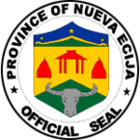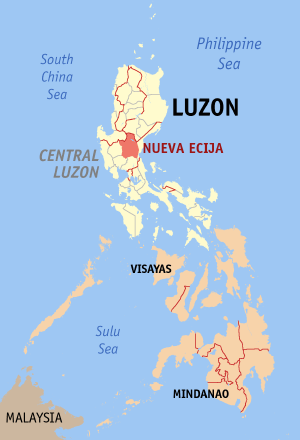Nueva Ecija
| Province of Nueva Ecija | |
 Provincial seal of Nueva Ecija |
|
 Map of the Philippines with Nueva Ecija highlighted |
|
| Region | Central Luzon (Region III) |
| Capital | Palayan City† |
| Divisions | |
| - Highly urbanized cities | 0 |
| - Component cities | 5 |
| - Municipalities | 27 |
| - Barangays | 849 |
| - Congressional districts | 4 |
| Population | 13th largest |
| - Total (2007) | 1,853,853 |
| - Density | 351 /km² (909 /sq mi) (18th highest) |
| Area | 16th largest |
| - Total | 5,284.3 km2 (2,040 sq mi) |
| Founded | 1705 |
| Spoken languages | Tagalog, English, Kapampangan, Ilocano, Pangasinan |
| Governor | Aurelio Matias Umali (Lakas-CMD) |
| †Palayan City is the officially-designated capital and seat of government by R.A. 4475, though the provincial government still maintains its facilities in Cabanatuan City. | |
Nueva Ecija (PSGC: 034900000; ISO: PH-NUE) is a landlocked province of the Philippines located in the Central Luzon region. Its capital is Palayan City. Nueva Ecija borders, from the south clockwise, Bulacan, Pampanga, Tarlac, Pangasinan, Nueva Vizcaya, and Aurora.
Contents |
People and culture
Nueva Ecija ("New Écija") was settled in the last century by thousands of migrants from adjoining provinces such as Pampanga, Tarlac, Bulacan, Pangasinan, and Ilocos. Today Novoecijanos are descendants of these settlers and many still hold on to folk traditions that trace their ancestry to other provinces. About 77% of the people speak Tagalog as their first language. Much of the remainder are Kapampangan, Pangasinan, and Ilocano-speakers and they are concentrated in the cities and towns of the south and north, respectively. There are small communities of Ilongots along the Caraballo and Sierra Madre Range as well as Agtas or Negritos.
Agriculture is the main industry of the people because of its naturally rich soil. Lowland crops such as rice, corn, onions, vegetables and sugarcane are produced in great quantities and Nueva Ecija is widely referred to as the "Rice Granary" of the country. Agriculture has played a vital role in molding the culture of the people. The typical Novo Ecijano family is tightly knit and is the basic working unit on the farm.
The May and June Festivals in Nueva Ecija are important Christian observances that are also occasions to ask for favors in ensuring a good harvest. In May, the Novo Ecijanos celebrate the feast of the patron of farmers, San Isidro. Food is served to overflowing in the belief that generosity results in bounty.
In Barangay Bibiclat, in the town of Aliaga there is a unique practice among the devotees of Saint John the Baptist. They cover their bodies with mud and dry leaves and vines to denote the humble origins of the Saint. Known as the taong-putik or the mud people, they ask alms and candles from the people and offering them to the Church during the special mass celebrated at 7:00 in the morning. They believe that such a practice will cure sickness and bring a bounty in the harvest.

Economy
Nueva Ecija is considered the main rice growing province of the Philippines; also, the leading producer of onion (in the Municipality of Bongabon) in South East Asia.
Major Industries
Nueva Ecija is one of the top producers of agricultural goods in the country. Its principal crops are rice, corn, and onion. The province is often referred to as the “Rice Granary of the Philippines.” Other major crops are mango, banana, eggplant, and garlic.
Fishponds are unevenly distributed throughout the province but the largest concentrations are in San Antonio, Sta. Rosa, and Cuyapo.
Several areas have mineral deposits. Copper and manganese have been found in Gen. Tinio, Carranglan, and Pantabangan. The upper reaches of Carranglan and Palayan City are said to contain gold.
In June 2008, it has also received the title: "Milk Capital of the Philippines" due to the reason that Nueva Ecija gathers more milk from both cows and kalabaws (water buffalo) than any other place in the Philippines.[1]
Geography
The province is the largest in Central Luzon. Its terrain begins with the southwestern marshes near the Pampanga border. It levels off and then gradually increases in elevation to rolling hills as it approaches the mountains of Sierra Madre in the east, and the Caraballo and Cordillera ranges in the north.
Political
The governor as of 2007 is Aurelio Matias Umali, who assumed his governatorial duties after winning the 2007 election.
The province is divided into four congressional districts which consists of 27 municipalities and 5 cities.
Nueva Ecija is a landlocked province of the Philippines located in the Central Luzon region. Its capital is Palayan City. Nueva Ecija borders, from the south clockwise, Bulacan, Pampanga, Tarlac, Pangasinan, Nueva Vizcaya, and Aurora.
Cities
- Cabanatuan City
- Gapan City
- Palayan City
- San Jose City
- Science City of Muñoz
Municipalities
|
|
Physical
History
Nueva Ecija was created as a military comandancia in 1777 by Governor General Clavería, with the capital, Josean at Baler (now part of Aurora). It was formerly part of the province of Pampanga. From its humble beginning, its land area grew to cover almost the entire island of Luzon. Spanish Records in the Philippines recognizes 2 Spanish countries in the Pacific-- Las Islas Filipinas and Nueva Écija. Poverty was the only reason why Nueva Ecija was not given recognition as a separate country from the Philippines by the King of Spain in 1840s. From 1777 to 1917, Nueva Ecija's territory was however subdivided to give way to the creation of other provinces. The Province of Tayabas (now Aurora and Quezon) including Polillo Islands, the provinces of Palanan (now Isabela), Cagayan, the province of Nueva Vizcaya, the territory which became part of the Province of Quirino, and the province of Manila north of the province of Tondo in 1867, and the District of Morong (now Rizal) were among those created out of Nueva Ecija.
During World War II the Imperial Japanese Army entered the province and Nueva Ecija was taken in 1942. In February, 1942, under the leadership of Luis Taruc the Hukbalahap (Hukbo ng Bayan Laban sa Hapon-People's Army Against the Japanese) which was the military arm to the Communist Party of the Philippines, began to attack Japanese forces from the villages of Sitio, Bawit, Baryo, San lorenzo and Cabiao. Thousands of these Filipino guerillas would engage the Japanese in Nueva Ecija. In 1945, American and Filipino forces liberated Nueva Ecija with Filipino guerillas continuing to harass the Japanese at every opportunity. On January 30, 1945 American Army Rangers, Alamo scouts and Filipino guerillas conducted a raid to liberate Allied civilians and prisioners of war in Cabanatuan, this was successful with over 516 rescued. By January 31, 1945, the liberated civilians and POWs reached Talavera, the rescue is commemorated in Talavera.
The province was named after the old city of Écija in Seville, Spain.
In 1896, Nueva Ecija became one of the first provinces to revolt against Spanish rule, and one of the provinces which declared its independence in 1898.
Tourist Attractions
Nueva Ecija is the largest province and the biggest rice producer of Central Luzon and the Philippines, thus, often referred to as the “Rice Bowl of the Philippines.”
References
- ↑ TV Patrol North Central Luzon
See also
- Super regions of the Philippines
- Nueva Ecija University of Science and Technology [1]
- [2] http://angelishoppingmall.coolpage.biz/
External links
- Nueva Ecija Today
- Nueva Ecija Mall
- Official Website of the Province of Nueva Ecija
- GTNHS Alumni Online - Gen. Tinio, Nueva Ecija
- Central Luzon Local Business Directory
- Executive Order No. 561: Formation of the "Super" Regions and Mandate of the Superregional Development Champions
- North Luzon Super Region: Potentials
- North Luzon Super Region: Projects
- GMA NEWS.TV, Nueva Ecija honors winners in Giant Lantern Festival, 12/25/2007
- accessmylibrary.com, Weekender: Travel & Tourism
- NE Head Officials
- Nueva Ecija Online Community Beta
- Philippine Tourism
- [3]
 |
|
| Cities and Municipalities of Nueva Ecija | |
| Cities: | Cabanatuan | Gapan | Muñoz | Palayan | San Jose |
| Municipalities: | Aliaga | Bongabon | Cabiao | Carranglan | Cuyapo | Gabaldon | General Mamerto Natividad | General Tinio | Guimba | Jaen | Laur | Licab | Llanera | Lupao | Nampicuan | Pantabangan | Peñaranda | Quezon | Rizal | San Antonio | San Isidro | San Leonardo | Santa Rosa | Santo Domingo | Talavera | Talugtug | Zaragoza |